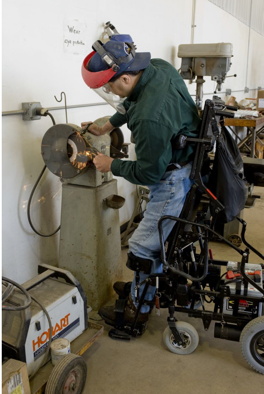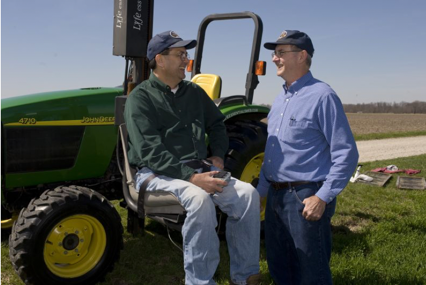Introduction
I want to thank everyone for this opportunity to share the program AgrAbility with you today. First, I want to talk in general about disability in agriculture, and then more specifically about the program and how we try to accommodate people with disabilities in agriculture. I also want to tell you about how occupational therapy interfaces with our program and with other issues of disability in agriculture.
Today, I want to start out with a video example of one of the clients that we have worked with. I think this will probably give you a better feel for some of the things that we do for the topic of disability in agriculture than any particular facts I can present to you.
Video Case Study

This is a draft of a promotional video that we are working on. I wanted to show it to you to give you a real-life example of disability in agriculture and also some of the things that we do in AgrAbility.
One of the main points of the video is that farming is not just a job. I know that is the case with many occupations. But, with farmers and ranchers, the occupation is a lifestyle and an identity in many cases. Another thing is that even severe disabilities can be accommodated. Sometimes, there is an assumption that people with significant disabilities cannot continue in a job that is physically demanding. And obviously, not everyone that we work with has a disability to the severity of Eric's, but it is possible in many cases for people with severe disabilities to continue on with farming as seen in Figure 1.

Figure 1. Example of an accommodation.
Lastly, this video highlights the importance of support and networking. I think you could get a feel from the video that family support is important, but also networking with organizations like AgrAbility, vocational rehabilitation, and other agencies that we will talk about later.
Prevalence of Disability Within the Agricultural Community
- Deboy et al. (2008)
- Between 14% & 19.4% of the farm population (owner/operators, hired labor, farm family members) are impacted by disability
- 1.04 – 2.23 million of the U.S. farm, ranch, and agricultural community impacted by disability
- Miller and Aherin (2018)
- 12.9% of farm population (19.2% farmers, 9% farmworkers)
- 634,000 of the U.S. farm, ranch, and agricultural community impacted by disability
I now want to talk about the prevalence of disabilities within the agricultural community. There are two main studies I want to share with you. Deboy and others, in 2008, took some general statistics from the overall disability community and applied those to agriculture. The overall disability prevalence was estimated to be about 14% to 19.4% from surveys. And when those estimates were applied to how many people are in agriculture, not just farmers and ranchers but hired labor and even farm family members, the result was between about 1.04-2.23 million people. The reason for that wide range was the different definitions of what disability means and the different estimates of how we count people in agriculture.
In 2018, Miller and Aherin published a study where they focused mostly on the American Community Survey. Their estimate was that about 12.9% of the population had disabilities in the agriculture community. There were higher rates for farmers and lower for farmworkers. And, when they applied that to their estimate of the agricultural population, they came up with a potential of about 634,000 people involved in agriculture in the U.S. that might be impacted by a disability. So, it is not an exact science but rather an estimate. However, we think there is at least about 630,000 people in the agriculture community that may be impacted by disability. And, it could be more than that.
Causes of Disability within the Agricultural Community
- Traumatic injury. Agriculture is one of the most hazardous occupations (NSC, 2019). Many injuries also come from off-farm incidents.
- Spinal cord injuries
- Amputations
- Musculoskeletal damage
- Diseases and chronic health conditions
- Arthritis
- Back problems
- Multiple sclerosis
(National AgrAbility Project, 2017)
What are some of the causes of disability in agriculture? Obviously, agriculture is a dangerous occupation. It is usually ranked in the top three along with mining and construction and logging. Traumatic injuries are possible. Not only do dramatic injuries occur on farms, but they occur in other incidents off the farms. For example, spinal cord injuries often happen through car crashes. Amputations are not uncommon in agriculture because of the nature of the machinery that is used and some of the tasks. Other musculoskeletal damage can result from things like falls or contact with animals.
Diseases and chronic health conditions can also cause disability. These are things like arthritis, back problems, diseases, multiple sclerosis, cancer, and cardiovascular issues. In fact, the largest percentage of people that we work with in AgrAbility fall into this category of diseases and chronic health conditions rather than a traumatic injury. So, it is not just people that have farm accidents that we work with.
- Developmental disabilities
- Cerebral palsy
- Autism
- Deafness
- Blindness
In addition to what I have mentioned already, people with developmental disabilities are involved in agriculture (Figure 2).

Figure 2. Another accommodation example.
This could be cerebral palsy, autism, deafness, blindness, or any kind of disability that occurs at birth or at an early age.
- Effects of aging. The average age of principal operators in 2012 was 58. (USDA-NASS, 2018)
- Arthritis
- Cardiovascular disease
- Skin diseases from UV radiation
- Noise-induced hearing loss
- “Farmers’ lung”
- Chronic low back pain
(Hildebrand, 2015)
There are also factors related to aging. The average age of farmers, according to the USDA, is around 58, and that is the average. Obviously, there are people that are much older than that. Along with that come issues of arthritis and cardiovascular diseases. Decades of working out in the sun can result in skin diseases. The machinery on farms can be loud, and farmers do not always think about hearing protection. Respiratory issues like farmers' lung can result from inhaling grain dust, pesticides, and other things like that. And, chronic low back pain has been cited as another major factor of disability in agriculture for older workers.
Agricultural Risk Factors
- Extreme weather
- Rough terrain
- Farm machinery
- Unpredictable situations (fire)
- Excessive vibration and motion
- Respiratory hazards (chemicals, dust, molds)
- Handling livestock
- Falls
- Untreated impairments (visual/hearing)
- Length of the workday with limited breaks
- Repetitive tasks
- High stress
(Clingan, 2018; Gruver et al., 1997)
Agriculture has some unique risk factors. Often, it is activities that are outside in the weather that can be the most dangerous. Obviously, not everything involved in agriculture is outside, but much of it is, and it can be year-round. The terrain is often ruddy in fields and in farmyards. You are dealing with livestock all the way from the size of rabbits all the way up to a couple of thousand-pound animals. Large cattle can be dangerous. Other accidents involve falls from grain bins and haylofts. Farm machinery, again, is often dangerous. The workdays are long. Planting or harvesting can take upwards of 12 hours a day, most of that time with limited chance for breaks. If you are following the weather and farming, much of the Midwest are struggling with difficult weather. So, if it is dry enough, the farmers will just stay out as long as they can to get things planted. Another risk factor is the vibration caused by being in a machine for extended periods of time. This can cause issues for anybody, not just people with disabilities. And often, there are repetitive tasks. For example, bailing small bales of hay or straw or stacking hay are examples. I also talked about respiratory issues. Another thing is the stress involved in farming. Dealing with mental behavioral health issues can also be an issue. Farmers have to deal with not only the weather but financial pressures. With the trade wars going on right now, farm prices are really low. Dairy has been low for several years and has been linked to suicides and other mental health issues.
Barriers to Increased Independence of Persons with Disabilities within Agriculture
- Attitudes: PWD, family, professionals
- Public policy that sometimes fosters dependence rather than independence
- Lack of access to appropriate assistive technology
- Cost of assistive technology and needed modifications
- Potential for secondary injuries
Apart from some of the work environment and other issues, what other barriers do we see? Attitudes can often be very high on the list. This could come from the person that has a disability. They may think that they can not continue on, or they may think they can do much more than they really should do. Sometimes, family members can be overly protective. Professionals may not have a box for disability and agriculture. They may be trained to think more in terms of retraining them for office work. And from the video, I think you can see that is not an acceptable answer for many people in agriculture.
Policies sometimes can be a barrier. While farmers may not have a lot of cash flow, they might have a significant amount of capital that is locked up in land or equipment. There can be issues of continuing on or earning income while maintaining some needed public benefits.
Rural people do not have the same access to assistive technology that some in the urban areas do. And obviously, the cost of some of that technology can be a barrier. Some of the technology involved like the lift in the back of that truck might run $40,000, in addition to having a suitable truck. So, the cost can be a barrier.
Another barrier to people in agriculture with disabilities can be the issue of secondary injuries. Sometimes disabilities can lead to other injuries. I mentioned being in a tractor for 12 hours a day. If you have paralysis, long seated hours can lead to pressure ulcers. These are just some of the barriers that can be attributed to disability in agriculture.
AgrAbility Mission
- The vision of AgrAbility is to enhance the quality of life for farmers, ranchers, and other agricultural workers with disabilities.
- Through education and assistance, AgrAbility helps to eliminate (or at least minimize) obstacles that block success in production agriculture or agriculture-related occupations.
I want to shift here a little bit and talk about what we do with AgrAbility. Our focus is to enhance the quality of life for people in agriculture. We do that through a variety of methods that I am going to talk about, but again we are just trying to eliminate some of those barriers that I just mentioned that can impede people's success for continuing on in agriculture.
AgrAbility History
- AgrAbility began in 1991 as part of the USDA Cooperative State Research, Education, and Extension Service (now NIFA).
- In 1991, there were 8 funded state and regional AgrAbility projects (SRAPS); as of 2019, there are 20 SRAPs and several previously-funded affiliate projects.
- One National AgrAbility Project (NAP) supports the SRAPs
- Competitive funding
Here is a little bit of background. At the federal level, the AgrAbility program started in 1991, and that was part of the 1990 Farm Bill. The funding did not start until 1991, and it is part of the USDA's Extension Service. You may not be familiar with Extension, but every county in the United States has some type of Extension presence. There may be an Extension office in the county itself, or it may be a shared office in another county, but there are Extension agents or educators that cover every county. They deal with things like agriculture, how to plant crops, what is new with drones in agriculture, or anything related to agriculture. The program 4-H is included in Extension. There is also usually someone that deals with consumer and family science issues, health, and even canning of foods. There may be other educators related to Extension in the counties.
Prior to 1991, there were programs like the one here at Purdue that helped people with disability in agriculture, but it was not a federal program at that time. When the program started in 1991, there were eight projects. As of 2019, there are 20 projects around the country, state projects. There are several projects that are no longer funded directly by USDA but continue on to provide some services through other funding streams. We call those affiliate projects. In addition to the 20-state projects, there is one National AgrAbility Project. I will talk a little bit about the functions of that project in just a minute, but the main job of the national project is to support the state projects. You may wonder why there are only 20, and it boils down mainly to an issue of funding. There is only enough money at this point to provide for 20 state projects, so the funding is competitive. There is no guarantee that a project that is funded now will continue after its grant cycle ends because of its competitive nature. I will talk a little bit more about how that grant process works in a minute and who can actually be part of AgrAbility grants. Figure 3 shows a map of the current AgrAbility projects.

Figure 3. AgrAbility projects.
The yellow projects are those that have some level of USDA funding right now. They are either fully funded, or they are continuing on with some residual funds from a previous project. Our newest projects that were just funded in 2018 are in Alaska, New Mexico, and South Dakota. Some of these are more unusual projects, like Alaska for example. One does not think of Alaska as a big farming state. But when you include fishing, by some definitions, that is part of agriculture and that is a major industry there. South Dakota is one of the more unique projects that have been funded because it focuses primarily on the Pine Ridge Indian Reservation in South Dakota, dealing with maybe some nontraditional issues that we do not think of in AgrAbility as much. These are issues of mental-emotional health rather than physical, although they are also dealing with physical disability issues as well. Additionally, food security, poverty, and other issues are not typically addressed by AgrAbility projects.
Whom Does AgrAbility Serve?
- AgrAbility addresses a wide variety of functional limitations in agriculture, including, but not limited to:
- Amputation
- Arthritis
- Back impairment
- Deafness/hearing impairment
- Development disabilities, such as cerebral palsy or autism
- Disabling diseases, such as cancer or heart disease
- Mental/behavioral health problems
- Respiratory diseases
- Spinal cord injuries
- Stroke
- Traumatic brain injury
- Visual impairments
In terms of disabilities, what types of disabilities do we try to address in AgrAbility? The short answer is that we try to deal with the entire spectrum. A better term than disability would be a functional limitation. Farmers might have severe arthritis or back problems that limit their ability to do their tasks or even they may be missing a few fingers or even a hand. They might not think of themselves as having a disability.
